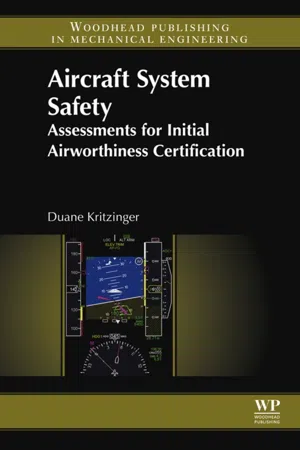
Aircraft System Safety
Assessments for Initial Airworthiness Certification
- 422 pages
- English
- ePUB (mobile friendly)
- Available on iOS & Android
About this book
Aircraft System Safety: Assessments for Initial Airworthiness Certification presents a practical guide for the novice safety practitioner in the more specific area of assessing aircraft system failures to show compliance to regulations such as FAR25.1302 and 1309. A case study and safety strategy beginning in chapter two shows the reader how to bring safety assessment together in a logical and efficient manner.Written to supplement (not replace) the content of the advisory material to these regulations (e.g. AMC25.1309) as well as the main supporting reference standards (e.g. SAE ARP 4761, RTCA/DO-178, RTCA/DO-154), this book strives to amalgamate all these different documents into a consolidated strategy with simple process maps to aid in their understanding and optimise their efficient use.- Covers the effect of design, manufacturing, and maintenance errors and the effects of common component errors- Evaluates the malfunctioning of multiple aircraft components and the interaction which various aircraft systems have on the ability of the aircraft to continue safe flight and landing- Presents and defines a case study (an aircraft modification program) and a safety strategy in the second chapter, after which each of the following chapters will explore the theory of the technique required and then apply the theory to the case study
Frequently asked questions
- Essential is ideal for learners and professionals who enjoy exploring a wide range of subjects. Access the Essential Library with 800,000+ trusted titles and best-sellers across business, personal growth, and the humanities. Includes unlimited reading time and Standard Read Aloud voice.
- Complete: Perfect for advanced learners and researchers needing full, unrestricted access. Unlock 1.4M+ books across hundreds of subjects, including academic and specialized titles. The Complete Plan also includes advanced features like Premium Read Aloud and Research Assistant.
Please note we cannot support devices running on iOS 13 and Android 7 or earlier. Learn more about using the app.
Information
Introduction
Abstract
Keywords
1.1. Introduction to System Safety Assessments
1.1.1. Background
1.1.2. Aim of a System Safety Assessment
1.1.3. Objectives of a System Safety Assessment
Table of contents
- Cover image
- Title page
- Table of Contents
- Related titles
- Copyright
- Preface
- Acknowledgements
- 1. Introduction
- 2. Safety assessment strategy (with Goal Structuring Notation)
- 3. Functional Hazard Analysis
- 4. Fault tree analysis
- 5. Failure Modes and Effects Analysis
- 6. Common Mode Analysis
- 7. Particular risk analysis
- 8. Zonal Safety Analysis
- 9. Development Assurance
- 10. Crew errors in the safety assessment
- 11. Continuing safety
- Abbreviations
- Definitions
- Index